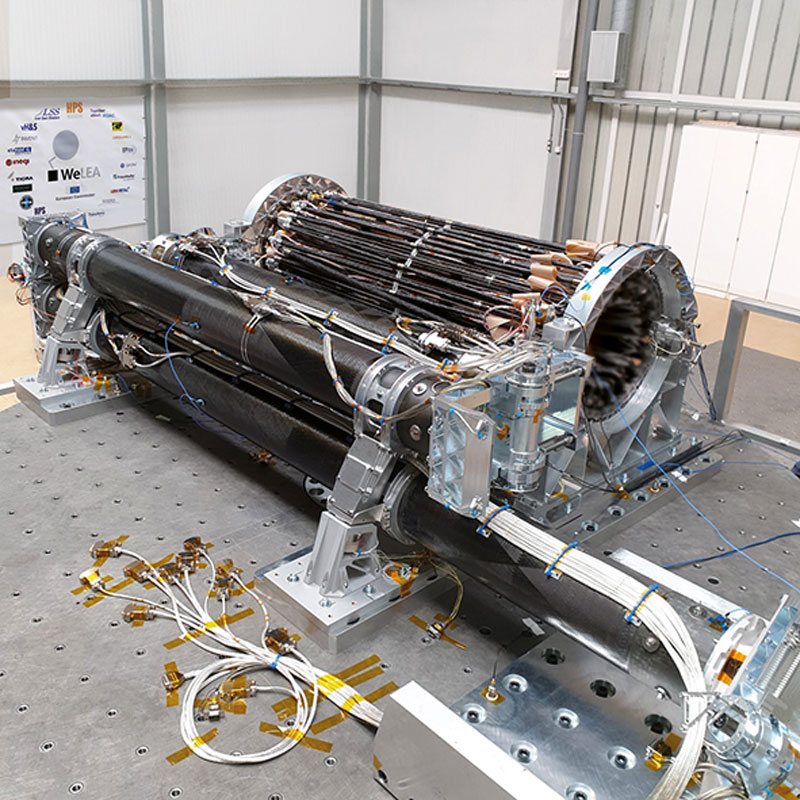Inspektion des HPtex-Mesh für ESA’s CIMR-Satellitenmission erfolgreich abgeschlossen
Hightech aus Bayern für Europas Raumfahrt: Inspektion des HPtex-Mesh für ESA’s CIMR-Satellitenmission erfolgreich abgeschlossen
Ein wichtiger Meilenstein im europäischen Raumfahrtprogramm CIMR (Copernicus Imaging Microwave Radiometer) wurde am 24. Juni 2025 erreicht: In der neuen Hightech-Reinraum-Assembly-Hall von HPS in München Süd wurde das speziell entwickelte Raumfahrt-Mesh der HPtex GmbH erstmals vollständig inspiziert und freigegeben – der erfolgreiche Abschluss eines mehrjährigen Entwicklungs- und Fertigungsprozesses.
Gefertigt wurde das Mesh von der auf Raumfahrtmeshes spezialisierten HPtex GmbH aus Oberfranken, der ultrafeine Draht stammt vom schwedischen Langzeitpartner LUMA WIRE TEC – ein Paradebeispiel für internationale Hightech-Zusammenarbeit in der europäischen Raumfahrt.
Im Fokus der Inspektion stand das Universal Space Mesh USM TUCH 32, eine hochspezialisierte Struktur aus extrem feinen Metallfäden. Mit einer Dichte von 32 Nadeln pro Zoll (E32) und einem Flächengewicht von nur ca. 40 g/m² zählt das TUCH 32 zu den leichtesten und präzisesten Meshes seiner Art. Produziert wurde es in zwei Varianten mit Drahtdurchmessern von 20 µm und 25 µm.
Mit beeindruckenden Abmessungen von 10,2 x 9,5 Metern gehört dieses Mesh zu den weltweit größten seiner Art – ein echtes Aushängeschild europäischer Ingenieurs- und Textilkunst. Entwickelt wurde es speziell für die Anwendung im Ka-Band, einem besonders anspruchsvollen Frequenzbereich, der höchste Anforderungen an die RF-Eigenschaften des Materials stellt. Genäht wurden die einzelnen Mesh-Bahnen seitens HPtex mit einer umentwickelten Nähmaschine in einem nun vollautomatisierten und berührungslosen Nähprozess. Dank der großen Wirkbreite (über 4 m) der hauseigenen Hochleistungswirkmaschinen waren nur zwei Nähte nötig, um dieses große Mesh zusammenzusetzen.
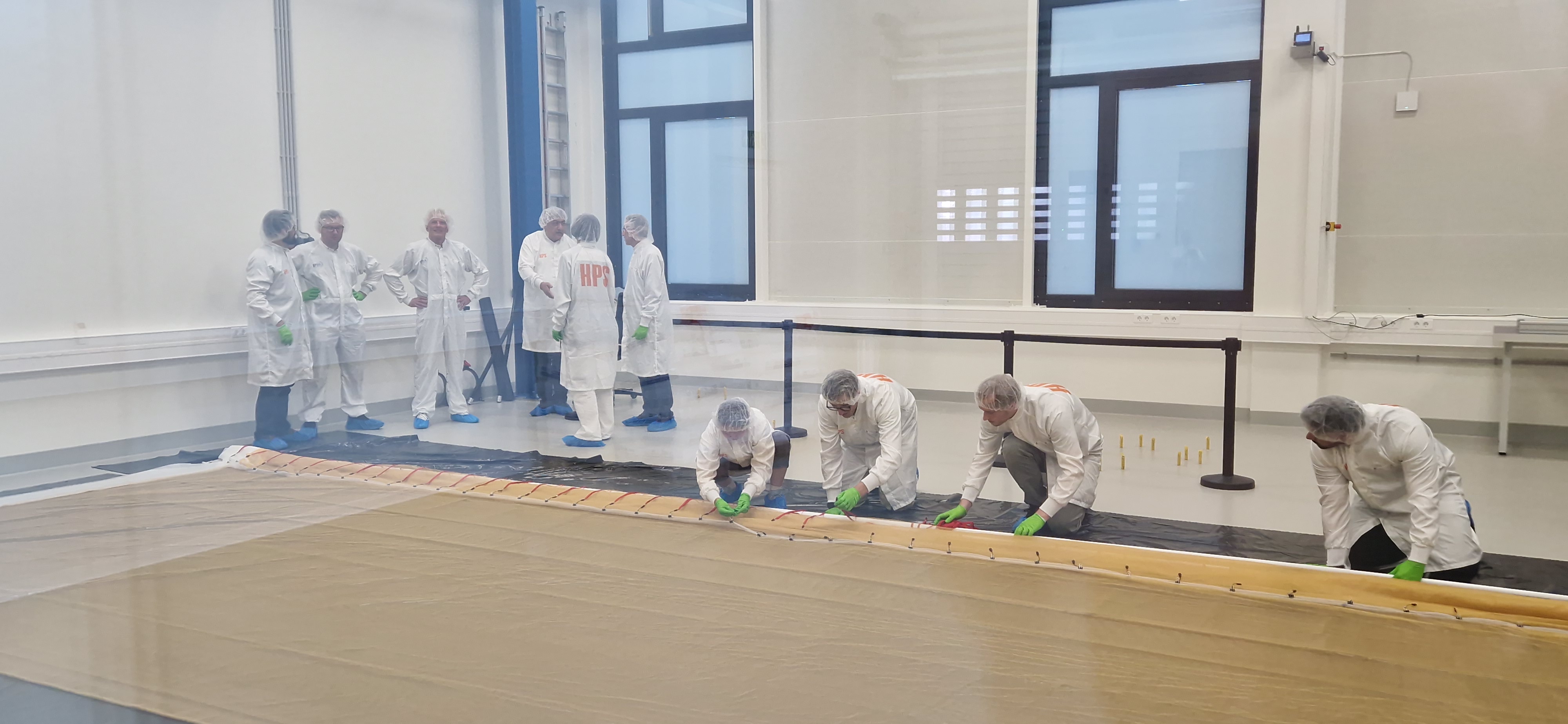

Die Inspektion wurde von einem hochkarätig besetzten Team begleitet – darunter Vertreter der
- ESA als Endkunde,
- TAS-Italia als direkter Kunde von HPS,
- LSS (Unterauftragnehmer und Partner für die entfaltbare 8-Meter-Reflektorstruktur),
- HPtex (via ihrem CEO und Schlüsselpersonal an den Maschinen),
und des verantwortlichen Team von HPS (Large Deployable Reflector Subsystem-Prime und zuständig für Mesh-Test & Charakterisierung).
Das Mesh ist das Ergebnis von über vier Jahren Entwicklungsarbeit im Rahmen des CIMR-Programms, das wiederum auf mehr als sechs Jahre Vorentwicklungen zurückblicken kann. Hunderte von mechanischen Dehnungstests wurden dazu auf der von HPS kontinuierlich weiterentwickelten Spezialanlage durchgeführt. Parallel dazu liefen ebenso viele RF-Tests – insbesondere auf der neuen, hochgenauen RF-Charakterisierungsanlage bei ESA/ESTEC –, um das Material auf seine elektromagnetischen Eigenschaften hin zu optimieren. Cyril Mangenot, ehemals RF-Spezialist bei ESA/ESTEC und einer der frühesten Unterstützer einer europäischen LDRS-Lösung auf Agenturseite unterstütze dabei für HPS die Meshentwicklung mit all seiner Erfahrung.
Als nächster Schritt steht nun die „Verheiratung“ des Meshes mit dem Engineering Qualification Model (EQM) des Kabelnetzwerks durch LSS bevor. Damit nimmt die Mission weiter Form an: Der CIMR-Satellit befindet sich aktuell in Phase C/D, mit dem Critical Design Review (CDR) geplant für das erste Halbjahr 2026.
Die Zusammenarbeit zwischen HPS, HPtex, LSS, TAS-IT, ESA und vielen weiteren Partnern gilt als Paradebeispiel für europäische Innovationskraft und Teamarbeit – ein echtes „Dream Team“, wie es intern oft genannt wird.
HPtex liefert als zentraler Hersteller Europas heute bereits Meshes an Kunden in aller Welt – von Amerika bis Asien. Mit dem Projekt CIMR unterstreicht das Unternehmen einmal mehr: Hightech aus Bayern spielt eine Schlüsselrolle in der globalen Raumfahrt.
CIMR-LDRS: Das Leuchtturmprojekt für Non-Dependence der europäischen Raumfahrt geht planmäßig in die Herstellungsphase des Qualifikationsmodells (EQM)
CIMR-LDRS: Das Leuchtturmprojekt für Non-Dependence der europäischen Raumfahrt geht planmäßig in die Herstellungsphase des Qualifikationsmodells (EQM)
Schon lange bevor 2022 ein unsägliches Blutbad das Ende friedvollen Lebens im Osten Europas besiegelte, hatte in der deutschen und europäischen Raumfahrt die Forderung nach technologischer „Non-Dependence“ eine Spitzenposition unter den strategischen Prioritäten erobert. Besonders im Fokus: große im Raum entfaltbare Reflektorantennen, geeignet für Missionen aller Art.
Die Geschichte dieser deutschen Technologie für Europa begann vor mehr als einem Jahrzehnt mit SCALABE, einer seitens ESA finanzierten Technologieentwicklung und SMERALDA (SME´s Radar and Large Deployable Antenna), einer von der deutschen Raumfahrtagentur finanzierten Studie mit maßgeblicher Beteiligung des Antennenspezialisten HPS GmbH. Über weitere technische Kapitel erfolgreicher Konkretisierung des Ziels mit maßgeblicher Unterstützung von ESA und EU führten die die Münchner schließlich 2020 ein Konsortium von meist mittelständischen Partnern aus acht Ländern zum spektakulären Gewinn des 115-Millionen-Euro Auftrags seitens des Prime`sThalesAlenia Space (TAS) für „CIMR LDRS“ (Large Deployable Reflector Subsystem): die größte rotierende entfaltbare Reflektorantennen-Konstruktion der Welt für das Copernicus-Leuchtturmprojekt CIMR (Copernicus Imaging Microwave Radiometer) der EU zur Beobachtung von Land, Eis und Ozeanen insbesondere der Arktis aus dem All unter dem Management der europäischen Raumfahrtagentur ESA. Das LDR-Subsystem besteht aus Reflektor, Arm, Entfaltelektronik, Verkabelung, verschieden Niederhaltemechanismen und Thermal-Hardware.
Nach langer Designphase und intensiver Iteration mit dem direkten Kunden TAS in Rom und dem Endkunden ESA erfolgte der Startschuss im Rahmen der Phase C/D durch den Abschluss des ersten so genannten „Manufacturing Readiness Review“ für Bau und Test eines Qualifizierungsmodells (Engineering Qualification Model, EQM). In diesen Tagen des Frühjahrs 2025 läutete nun HPS die intensive Phase der Herstellung des EQM endgültig ein.
Herausforderungen auf dem Weg zu neuen Ufern
Die technischen Herausforderungen waren und sind immens, denn Ziel ist kein geringeres als ein entfaltbares Reflektor-Konstrukt für hohe Frequenzen (Ka-Band) mit acht Metern Durchmesser an einem ebenfalls entfaltbaren acht Meter langen Arm, das sich im Orbit achtmal pro Minute um die eigene Achse dreht. Das resultiert in extremen Anforderungen wie etwa der eines RMS-Wertes (Root Mean Square) für die Oberflächengenauigkeit, der um einiges kleiner sein soll als 1/10 mm auf die gesamten 50 m² Reflektorfläche, oder einer erlaubten Abweichung der 8m entfernten Armspitze von maximal lediglich 10mm vom Nominalwert, Schwingungen, Zentrifugalkraft und Thermalverformungen inbegriffen.
Nicht weniger anspruchsvoll waren und sind die Herausforderungen an das Management der vielfältigen Aspekte des Projektes. Eine herausragende Rolle nimmt dabei von Anfang an die Programmleitung des CIMR-Teams der ESA und seitens TAS ein, während die für ihre Heritage im institutionellen, militärischen und kommerziellen Antennenbau bekannte HPS GmbH – neben der eigenen Entwicklungsarbeit auf Arm-und Subsystemlevel – die Führung des Konsortiums aus rund einem Dutzend KMU obliegt, darunter so herausragende Innovationstreiber wie die Münchner LSS GmbH für das entfaltbare Reflektorassembly (DRA), basierend auf einer höchst erfolgreichen, langjährigen Entwicklungspartnerschaft. Von der ehemaligen portgiesischen HPS-Tochter und heutigen FHP stammen die Leichtbau-Karbonstrebenfür das DRA, die INVENT GmbH steuert die kohlefaserverstärkten Rohre für den auf 8-Meter entfaltbaren Haltearm (DAA) bei, NanoSpace Schweiz entwickelt und produziert die hochgenauen und gleichzeitig stabilen, motorgetriebenen Gelenke des Arms, HPS-Rumänien und INEGI Portugal die Konstruktionen für Bodentests und Transporte („MGSE“). Darüber hinaus ist HPS verantwortlich für die Bereitstellung des Zentralelementes für den entfaltbaren Reflektor: das messbar beste Ka-band MESH von HPtex, das es in 9m x 9m Größe überhaupt zu kaufen gibt – und nebenbei als „made in Germany“ europäische Non-Dependence von der Vision in die Realität überführt. Denn ein MESH in solch Dimensionen gab es bis dahin nur aus amerikanischer Produktion. Ursprünglich als wesentliches Element der deutsch-europäischen Lieferkette für CIMR geplant, verkauft das 2020 gegründete Joint-Venture HPTex GmbH (JV aus Iprotex GmbH & Co. KG und HPS GmbH) mittlerweile seine Meshprodukte weltweit, insbesondere auch in asiatischen wie kontinentalamerikanischen Ländern. Das EQM-Mesh für CIMR ist kürzlich aus der HPtex-Fertigung gekommen.
Ende des Jahres stehen die wichtigsten Komponenten (DAA und DRA) bereit, die Serie der Tests beginnt früh in 2026.
„Wer vorne sein will, sollte keine Angst vor dem Unbekannten haben“ (Ernst K. Pfeiffer)
Wenn 2029 CIMR an Bord einer Vega C zu seiner Mission auf sonnensynchroner Bahn aufbricht, um jeweils von früh bis spät u.a. Eisschilde und Schnee unter Beobachtung zu nehmen, winkt Europa nicht nur der Gewinn der Erkenntnisse aus dem Projekt, sondern auch die Gewissheit, den Schritt zur technologischen LDRS-Unabhängigkeit gemeistert zu haben. LDRS sind eben auch Produkte für eine Reihe von militärischen Anwendungen, die gerade in diesen Jahren zu einer gesteigerten Verteidigungsfähigkeit beitragen können. HPS-CEO Ernst K. Pfeiffer sieht darin noch einen über den unmittelbaren Projekterfolg weit hinausreichenden Meilenstein: „Dieses Raumfahrtprojekt ist klarer Beleg dafür, dass die Mentalität aller Projekt-Beteiligten – der Industrie wie der Institutionen – eine ganz andere ist als die der Risikoscheu, welche die Öffentlichkeit vor allem Deutschland, teils auch der ESA normalerweise unterstellt. Keine Angst vor dem Unbekannten zu haben ist der erste Schlüssel zum Erfolg. Vorne ist nun mal da, wo es dunkel wird. Besonders im Weltraum. Aber eben nicht nur da.“
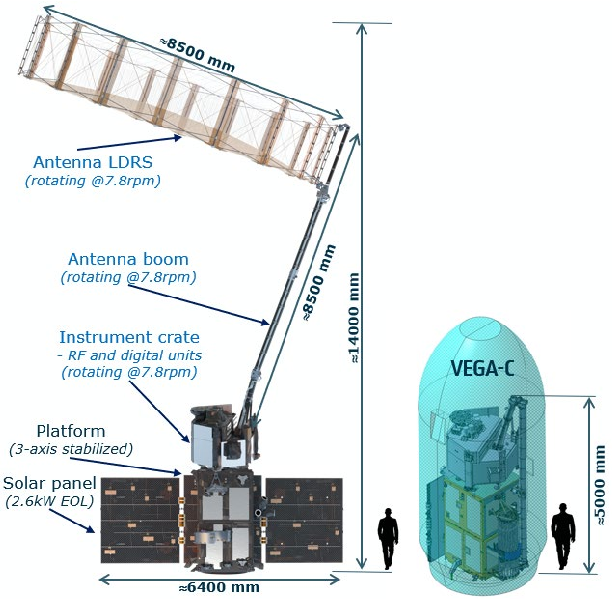
Größtes gemeinsames Innovationsprojekt der europäischen Raumfahrt: CEOs von TAS-I, HPS und LSS setzen Startschuss
Januar 2023
Größtes gemeinsames Innovationsprojekt der europäischen Raumfahrt: CEOs von TAS-I, HPS und LSS setzen Startschuss für Phase C/D der großen entfaltbaren Antenne „LDRS“ im Projekt CIMR
Seit dem spektakulären Gewinn des 110-Millionen € Auftrages für Entwicklung und Bau von LDRS (Large Deployable ReflectorSubsystem) durch das von HPS geführte KMU-Konsortium im Jahre 2020 läuft das Projekt zur Sicherung eines souveränen europäischen Innovationslevels trotz aller Komplexität wie auf Schienen. Das im Laufe der Entwicklung des Projektes stetig gewachsene Vertrauen des Endkunden ESA und seines Hauptauftragnehmers TAS-I für die Mission fand nun Ausdruck am 23.01.2023 in der Besiegelung des Aufbruchs in die Phase CD durch Unterschrift des so genannten „Rider“ für Bau und Test eines Qualifizierungsmodells (EQM) in 2023/2024, gefolgt von gleich zwei Flugmodellen (PFM und FM2).
Tragende Technologie-Säulen des Innovationsprojektes sind neben den Innovations-Hauptpartnern LSS (Entwicklung, Bau und Test des entfaltbaren Reflektors), die HPS-Tochter HPtex (Mesh-Produktion für den Reflektor), FHP (CFRP-Streben für den Reflektor), INVENT (CFRP-Rohr für den entfaltbaren Arm) und vH&S (für die Entfaltkontrollelektronik) weitere 10 Unternehmen aus sieben europäischen Ländern unter Konsortialführung von HPS.
Die Umweltbeobachtungsmission im Rahmen des Copernicus-Erdbeobachtungsprogramms der Europäischen Union ist wesentliches Element der europäischen Raumfahrtstrategie als hoch ambitioniertes Projekt im Bereich der Klimabeobachtung und der Auswirkungen des Klimawandels.
Foto (TAS-I): Vertragsbesiegelung – Mitte: Massimo Camparini (CEO des Raumfahrtkonzerns ThalesAleniaSpace Italien) und die Chefs von HPS, Ernst K. Pfeiffer (rechts) und von LSS, Leri Datashvili
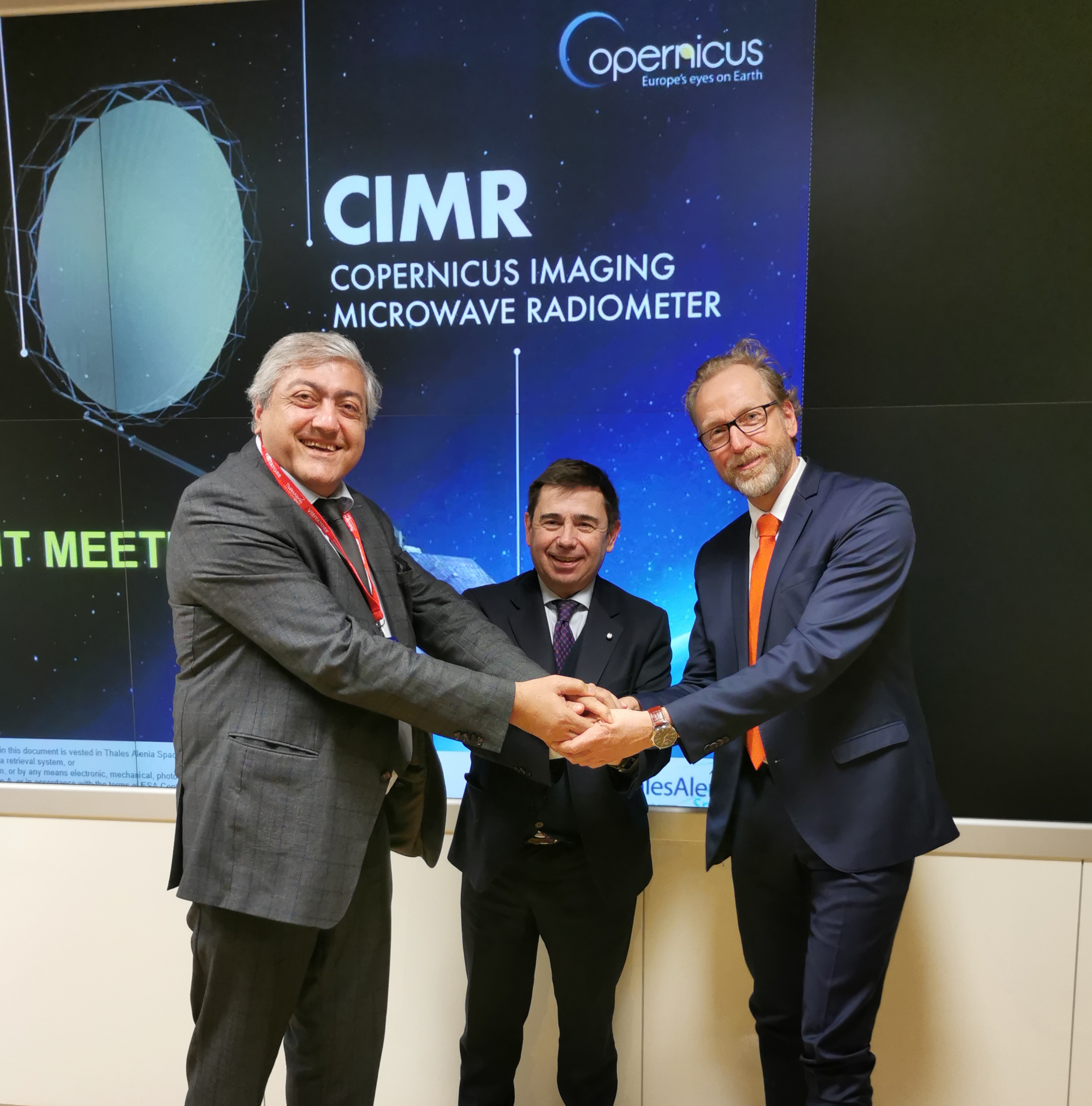
LEA-X5: New Movie on the completion of the European 5m X-band LDRS
Juli 2021
Gladly we announce with a new 20-minutes-movie the completion of the H2020-development „LEA-X5“, the 5m class European Large Deployable Reflector Subsystem (LDRS) operating in X-band.
The film itself is of course showing recent environmental and deployment tests, but it is mainly about PEOPLE, who are space engineers and space enthusiasts, and what they can achieve with combined powers and brains. These people, together with the enablers European Commission and European Space Agency, are making the achievement of „European Non-dependance“ happen.
LEA-X5 is a full LDRS-Subsystem (lead by HPS, Germany) and comprises the
- 5m diameter X-band reflector assembly (lead by LSS, Germany)
- the 5m long deployable arm assembly (lead by HPS, Germany),
- hinges & HDRMs (RUAG, DE),
- deployment electronics (vH&S, DE),
- thermal hardware (HPS/FHP).
Further partners of the H2020-consortium have been: INVENT (DE), FHP (PT), INEGI (PT), TICRA (DK), LUMA (SW), HPTEX (DE), ARQUIMEA(SP), HPS (RO), ETAMAX (DE), WSS (DE), ONERA (FR), TAS (FR), OHB (DE), Airbus (DE).
Most of the consortium members are introduced in the movie, inluding many interviews.
Take your time and enjoy the spirit of doing big things: LEA-X5 – European 5m X-band LDRS Completed (Final Report 06/2021) – YouTube
Best regards,
Your WeLEA-Consortium
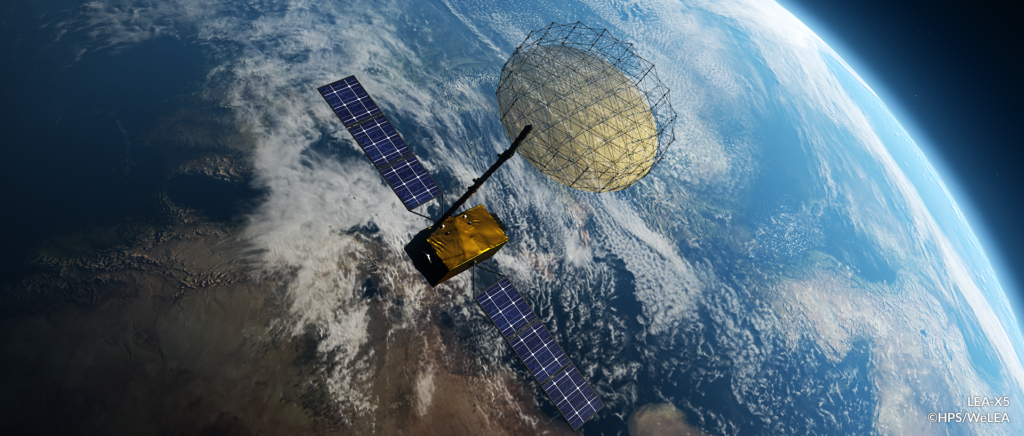
Oktober 2019
A European Declaration of Non-dependence in Space
Dear Friends and Fans of Europe in Space,
in the name of all members of our pan-European WeLEA-consortium we proudly present a video, documenting the successful road of the development of one of the most needed critical technologies in space: the Deployable Large European Antenna (LEA).
Invented, designed, tested and manufactured by more than 15 well known space companies from 7 European countries with a total staff of more than 500 dedicated specialists, representing a truly unique team of SMEs and Midcaps, the LEA-product is now taking shape as nothing less than “A European Declaration of Non-dependence in Space”.
Thanks to the farsighted vision of both powerful institutions responsible for our continent´s future in space, the European Space Agency ESA and the European Commission EC, LEA will become an invaluable technological asset to blaze our own trail towards knowledge and understanding as indispensable prerequisites to making this world a sustainable, better place – for life in diversity, for all citizens on the globe, and for one Europe across all its internal borders.
Within the WeLEA consortium HPS Germany, as prime contractor, is responsible for the project- and technical management of the whole LEA-subsystem, the deployable arm assembly and the reflective metal mesh.

März 2021
Europas innovative entfaltbare Antennentechnologie nimmt die nächste Hürde
Mit dem soeben bei INEGI erfolgreich abgeschlossenen Test des Deployable Assembly Arm (DAA), der die Deployable Reflector Assembly (DRA) mit dem Satelliten verbindet, hat das europäische LEA-Konsortium unter der Leitung von HPS die nächste Hürde bei der technischen Realisierung von Europas neuer Antennentechnologie genommen.
Der 5 Meter lange DAA besteht aus drei Gelenkmechanismen und zwei HDRMs (beide von RUAG Space Deutschland), Auslösemechanismen (von Arquimea, Spanien), drei CFK-Rohrsegmenten (von INVENT, Deutschland), Metallbeschlägen (teilweise von HPS Rumänien) und einer Deployment Control Electronics & EGSE (von Hoerner & Sulger). Fokus der Tests war einerseits die Verifikation eines gesamten Entfaltzyklus (dauert ganze 25 min.), andererseits die Verifikation der hoher Ausrichtgenauigkeit nach der Entwfaltung, sowie die Validierung der im Vorfeld erstellten thermo-elastischen mathematischen Modelle.
INEGI (Portugal) ist der Hauptpartner für den Arm-Entfaltungstest und ein guter Partner von HPS seit nunmehr über 13 Jahren. INEGI war verantwortlich für den 0-g-Simulationsprüfstand und den thermo-elastischen Verformungsprüfstand. Trotz der Pandemie und aller Einschränkungen konnten die Teams diesen Fortschritt mit höchster Motivation und engstem Kontakt zwischen INEGI/HPS-team vor Ort in Porto und den HPS-Ingenieuren in Deutschland bewältigen. HPS ist verantwortlich für die DAA und auch für das Umsetzungsmanagement der gesamten LEA-Aktivität. Das gesamte LEA-Team umfasst 15 Partner aus 7 Ländern; das Programm startete im Rahmen von H2020 im November 2017. Der Arm-Entfaltungstest und der TED-Test (thermoelastische Verformung) war einer der letzten Tests dieser H2020-Aktivität.
Der nächste Schritt – der noch im März beginnt – ist der Umwelttest (Vibration und thermisches Vakuum) des kompletten LDR-Subsystems (Reflektor, Arm und HDRM, alles miteinander verschraubt), der bei INTA in Madrid, Spanien, durchgeführt wird.
„LEA-X5“ (5m Reflektordurchmesser, 5m Armlänge, X-Band-Anwendung für Erdbeobachtung und Telekommunikation) wird inzwischen als eine der vorbereitenden Technologieentwicklungen für die aktuelle Copernicus CIMR-Mission gesehen.

März 2021
Arm and Reflector of LEA-X5 Successfully Mated to Form Complete Subsystem
Fifteen companies – mostly SMEs – from seven countries and one goal: a deployable 5-meter X-band-antenna as a preliminary development for the CIMR project, developed under the European H2020 program (2017-2021). For the first time ever, such a complete subsystem (HPS) has now been successfully assembled in Europe from the reflector- (LSS) and arm- (HPS) assemblies. Previously, the test deployment of the arm and reflector – each individually – had already been successfully passed.
LEA-X5-Subsystem is now at the premises of the consortium´s highly reliable test partner INTA in Spain, where vibration tests for the subsystem are on the agenda in the presence of the LSS- and HPS-teams. In a third round of testing, the subsystem will have to prove itself capable of withstanding the conditions of the thermal chamber.
The next complete subsystem-hardware in this context – the CIMR LDRS-EQM – will be assembled end 2023.
With the key technology behind LEA-X5, the continent is decisively expanding its independence from non-European sources.
